My Heathkit/Zenith Z-90

History of My Z-90
Back in 1981 the local city government purchased two Z-90's for their power grid control center. I can only guess that the system was used for financial or statistical information because Supercalc, which was a common spreadsheet program for the time, is lightly burnt into the screen. Inside the binders that I received with this system I discovered a few memos from city workers back in the 80's pertaining to modifications they made to the computers. I'm sure they never guessed how helpful those memos would be to a random guy some day! I was lucky that my system came with complete documentation. I have a binder for Z-90 hardware, Microsoft Basic-80, the CP/M operating system, and Supercalc. That includes complete schematics for the circuit boards. I received about twenty diskettes with the system.Arrival Condition
The dusty, dirty Z-90 showed up with squares of double-stick foam stuck all over it. Not to mention, the power cord was chopped off only three inches from the base. The computer hardware is accessed by sliding latches in the side, as shown on the right. It took me a little bit of trial to understand how they worked. Of course the graphic there I found much later. One of the latches was bent badly where someone had tried to pry it upward with a screwdriver instead of sliding it sideways.
It took me a little bit of trial to understand how they worked. Of course the graphic there I found much later. One of the latches was bent badly where someone had tried to pry it upward with a screwdriver instead of sliding it sideways.The diskettes I received were so deteriorated that I nearly didn't have a working operating system. Supercalc would boot, but would not warm-boot CP/M to allow me to copy it to a new disk. The other disks that would boot gave me several error messages about bad sectors.
The Z-90 also came with an external diskette drive. The drive was getting very hot, and even though my oscilloscope showed good power output, the capacitors were all bursting!
Making It Work
I started by peeling off adhesives and scrubbing the system down until every speck of dirt had been removed. After an hour of cleaning I still had no clue if the machine even worked... so I cracked it open and removed the top. Before I could test anything the cut power cable had to be replaced, so I unscrewed the AC input box and it dropped out the bottom. I unsoldered the old power cable and replaced it with a new one. After disconnecting the main computer from the power supply, I plugged in the new cord and tested the power supply output voltages and oscillation. To my relief, they were all correct. For the first time in at least fifteen years, the machine turned on. I half expected it to spit dust out the vents or something. This is actually the only 8-bit computer I have seen with a cooling fan.The BIOS on this machine is unlike any I've seen. It allows me to modify and view memory addresses, can scan the RAM for errors, and as I eventually discovered, can be told to boot from the diskette drive.
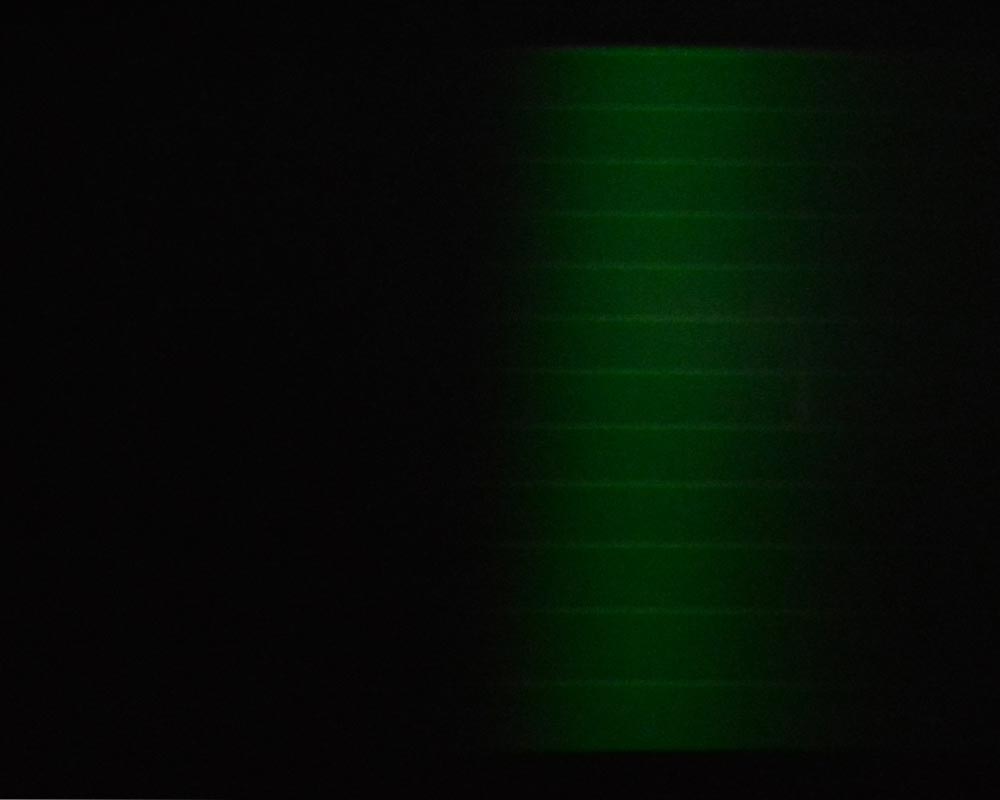 I used the focus adjustment to make the display a bit clearer, but I was unable to resolve one issue. The CRT, which is a green phosphor monochrome display, has a strange glow on the right, as shown in the graphic to the right. The glow is very faint and can only be seen in a dark room.
I used the focus adjustment to make the display a bit clearer, but I was unable to resolve one issue. The CRT, which is a green phosphor monochrome display, has a strange glow on the right, as shown in the graphic to the right. The glow is very faint and can only be seen in a dark room. Before reading any disks I cleaned the reader heads inside the floppy drives. The last modification I made to the hardware was to fix the faulty latch component, which I pounded flat with a hammer.
Even though I had quite a struggle with the corrupt floppy disks, I eventually found a solution. I took four system disks and merged the good files onto a new system disk, which I made bootable with the one disk that could still boot. I've made several copies of that disk. Without it this system would be a brick.
A Little Mystery
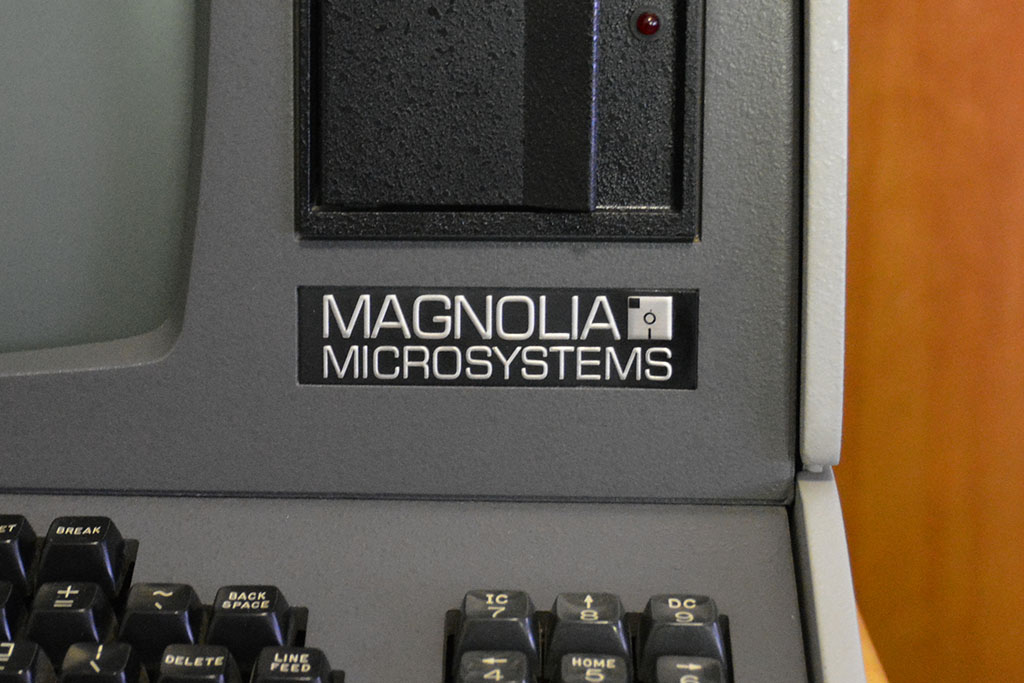 This Z-90 is like all other Z-90's in every respect except one. Instead of the Zenith Data Systems logo on the front, it features the manufacturer of the soft-sectored floppy disk controller, Magnolia Microsystems. I've made countless searches and I cannot find any record of a Z-90 being released under the Magnolia name. If you or anyone can answer my questions about the logo plate, please, I beg that you contact me and share your knowledge! I don't like unknowns.
This Z-90 is like all other Z-90's in every respect except one. Instead of the Zenith Data Systems logo on the front, it features the manufacturer of the soft-sectored floppy disk controller, Magnolia Microsystems. I've made countless searches and I cannot find any record of a Z-90 being released under the Magnolia name. If you or anyone can answer my questions about the logo plate, please, I beg that you contact me and share your knowledge! I don't like unknowns.
System Specifications
The specs of the Z-90 are very similar to other Zilog Z80 based systems. For example, the TRS-80 Model 4 and North Star Advantage have essentially identical specifications. Nearly everything ran on the Z80 processor and sported 32-64 KB of RAM.| Processor | 2.048 MHz Zilog Z80 (one for the terminal, and one for the main system) |
|---|---|
| Memory | 64KB total (48KB on-board, and 16KB expansion memory) |
| Display | 12 inch green phosphor monochromatic CRT |
| Video Output | 80 by 25 characters (characters of 8 by 10 dot-matrix) |
| ROM Size | 2KB or 4KB (depending on configuration) |
| Communication Interfaces | 3x RS232 parallel connections, 1x standard external floppy disk connector |
| Storage Devices | A single 5.25 inch double-height single-sided double-density floppy disk drive (support for up to four double-sided double-density drives), support for standard cassette writing, reading, and audible playback |
| Manufacturer | Heath, Zenith Data Systems, and Magnolia Microsystems. |
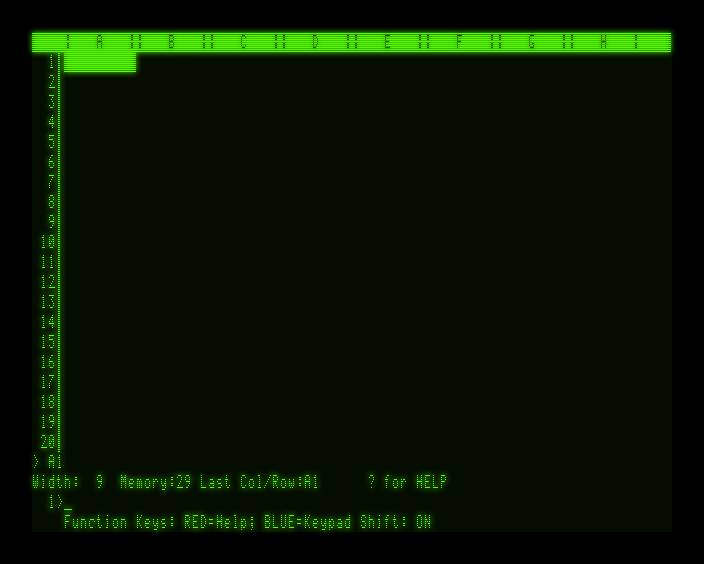
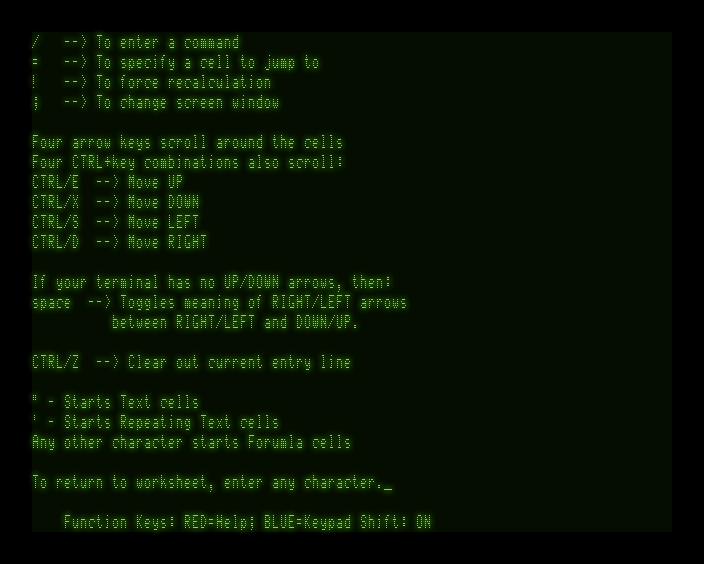
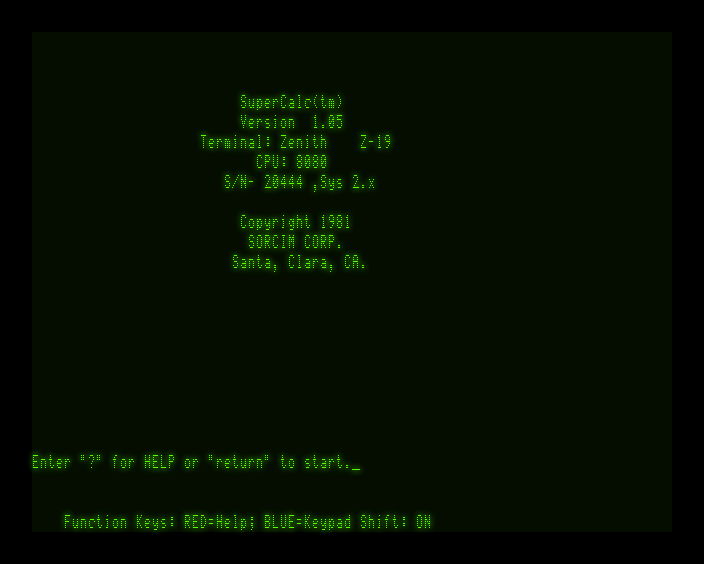

 The ESP8266 and ESP8285 can run your Arduino code directly, in many cases with more program space, more RAM, and a faster CPU.
The ESP8266 and ESP8285 can run your Arduino code directly, in many cases with more program space, more RAM, and a faster CPU.
 Squirrel lighting controller utilizes Wi-Fi microcontrollers to vary the color and brightness of multiple Wi-Fi-enabled LED light bulbs.
Squirrel lighting controller utilizes Wi-Fi microcontrollers to vary the color and brightness of multiple Wi-Fi-enabled LED light bulbs.
 Is the volume adjustment stuck or faulty on your Ford radio? This is a technical guide to a potential fix.
Is the volume adjustment stuck or faulty on your Ford radio? This is a technical guide to a potential fix.
 This article covers how to take multiple bootable ISO images and create a single bootable USB key for all of them.
This article covers how to take multiple bootable ISO images and create a single bootable USB key for all of them.
 Are you sick and tired of IDEs? This tutorial will show you how to configure Notepad++ macros to compile your code, so you can ditch big IDEs forever.
Are you sick and tired of IDEs? This tutorial will show you how to configure Notepad++ macros to compile your code, so you can ditch big IDEs forever.
 This article is the hub for my collection of classic computers. From this page you can see the story behind each of my systems, their specifications, screen shots, and more.
This article is the hub for my collection of classic computers. From this page you can see the story behind each of my systems, their specifications, screen shots, and more.
 The NVidia GeForce GT 7800 has an issue with its cooling fan circuitry that causes it to get stuck at max speed. This article covers removing a faulty transistor from the device to circumvent this issue.
The NVidia GeForce GT 7800 has an issue with its cooling fan circuitry that causes it to get stuck at max speed. This article covers removing a faulty transistor from the device to circumvent this issue.
 Are you tired of the painful speed of Windows Vista? This article covers a number of simple ways to improve your desktop performance.
Are you tired of the painful speed of Windows Vista? This article covers a number of simple ways to improve your desktop performance.
 This article explains the game that everyone seems to be talking about, Minecraft.
This article explains the game that everyone seems to be talking about, Minecraft.